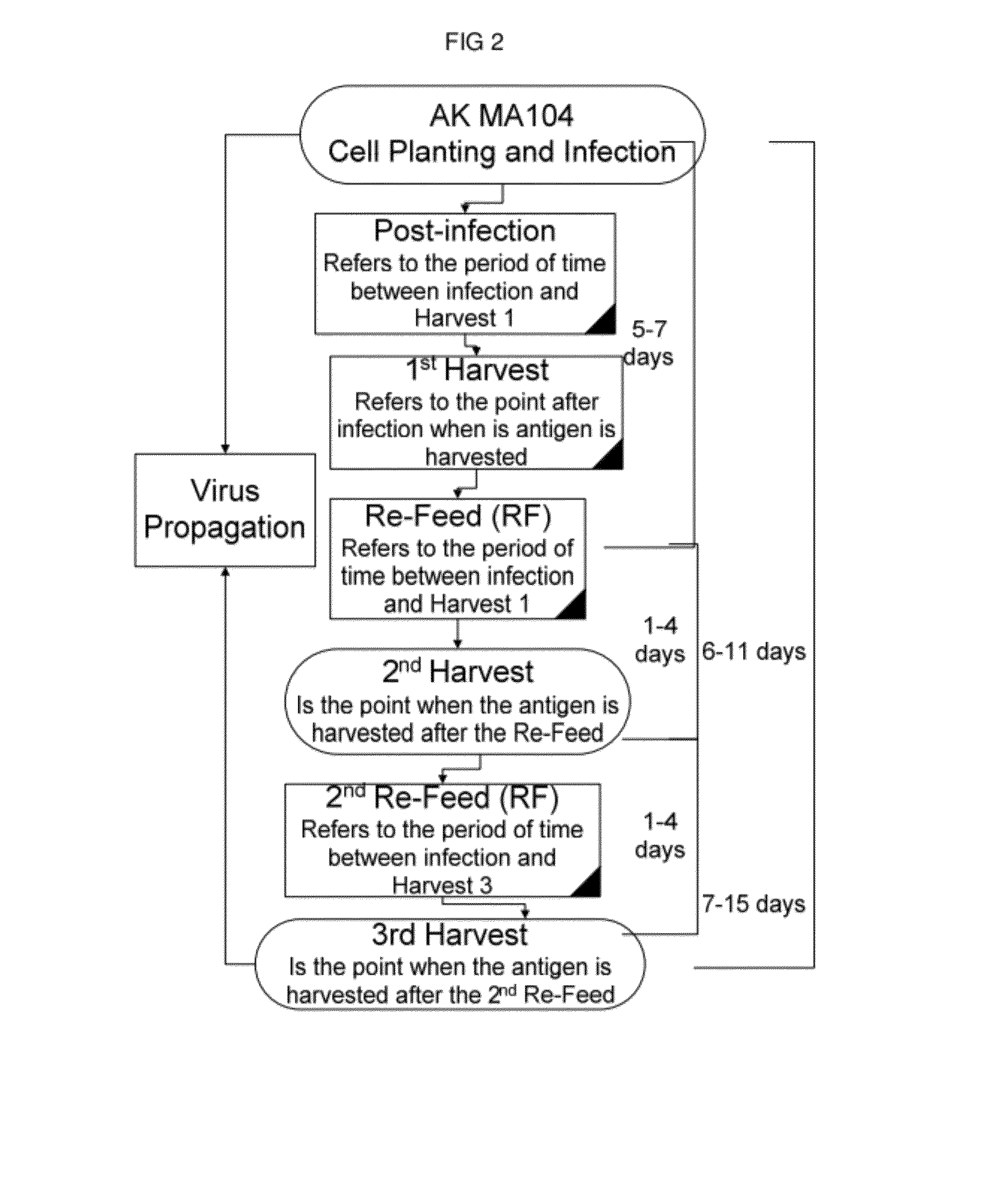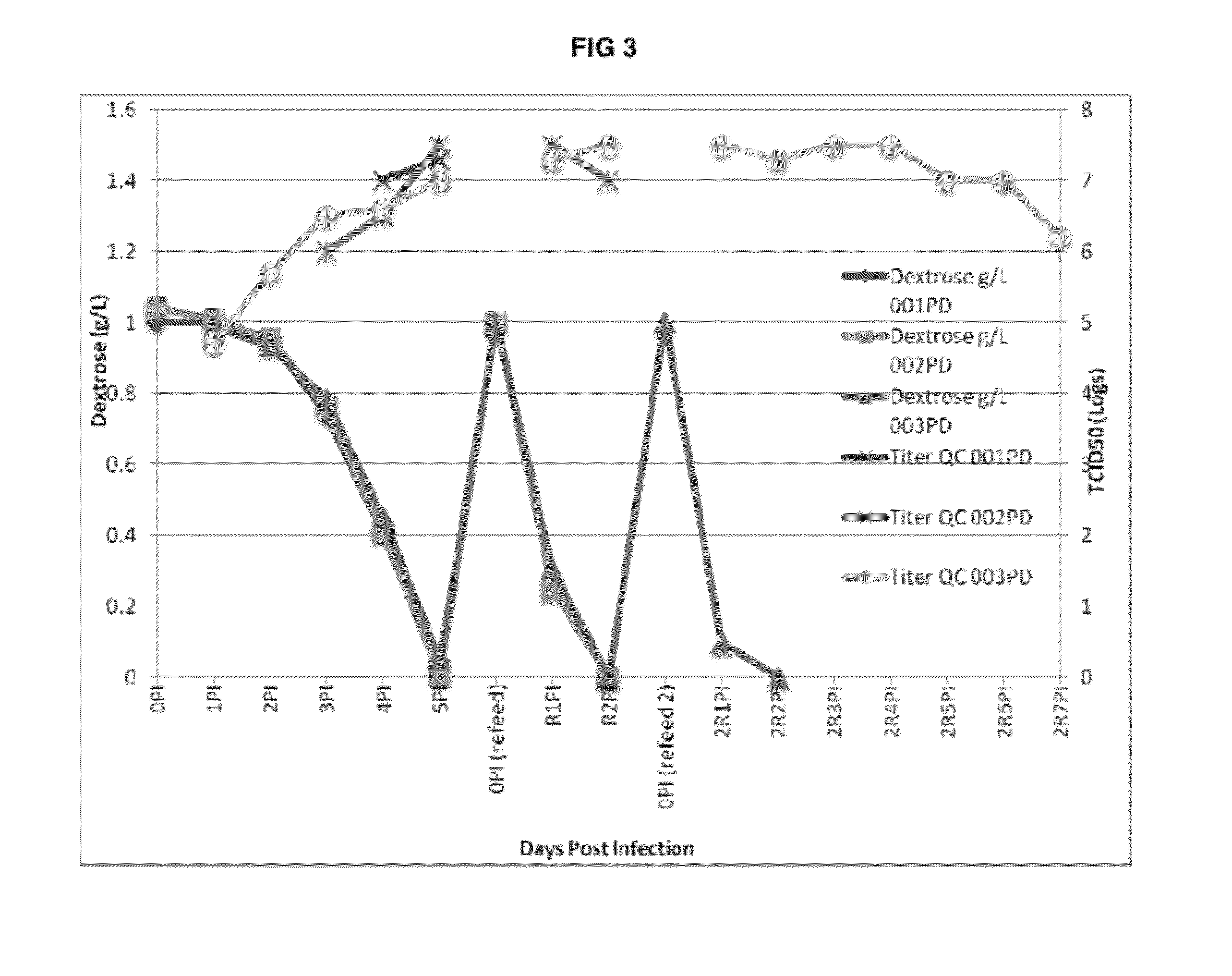Commercial scale process for production of prrsv
- Summary
- Abstract
- Description
- Claims
- Application Information
AI Technical Summary
Benefits of technology
Problems solved by technology
Method used
Image
Examples
example 1
Exemplary Scale-Up for Production of PRRSV 94881 MLV
[0068]The 300 L bioreactor process scale up for PRRSV 94881 used MA104 cells that were between 64-84 passage. These cells were expanded in 850 cm2 Roller bottles (Corning). The cells were cultured concurrently with virus infection in 300 L air-lift Bioreactors. Throughout the culture process the media dextrose / lactate concentrations were monitored in g / L. At harvest of the fluids were discarded and the virus samples were retained.
[0069]The media compositions was as shown in the following table:
ComponentQuantityFetal Bovine Serum5%Gamma irradiatedMEM without Phenol Red Powder9.6 g / LNeomycin Sulfate 30 mg / LSodium Bicarbonate1.4 g / LHydrochloric acidTo adjust pH
[0070]The MEM without Phenol Red medium, neomycin and 1.4 g / L sodium bicarbonate were prepared and filtered. The FBS was added to the media concurrently with the media being placed in the bioreactor. The amount of neomycin added is calculated by: vol(L)×30 mg / L÷Potency (mg / g bas...
example 2
[0103]In a specific example the PRRSV 94881 produced according to the method described above was used to determine the efficacy of the PRRSV 94881 in vaccinating pigs. In this study, Piglets from 4 to 13 days old were vaccinated intramuscularly with a composition comprising 107.6 TCID 50 in 2 ml (day 0 of study). At day 13, the piglets were weaned and were monitored for various disease parameters through to day 90. Study parameters included monitoring viremia, presence of virus in tissues and secretions, clinical observations, lung lesions and weight gain.
[0104]Each of the study groups: the vaccinates, the sentinels and the controls were weighed on study day 0, 14, 28, 56 and 90. Blood was sampled every alternate day between days 0 and 14 and once a week to day 90 for both the vaccinated group and the sentinels and once a week throughout the study periods for the controls up to day 90.
[0105]Nasal, oral and faecal swabs were taken every alternate day between days 0 and 14 and once a ...
example 3
[0111]The following equipment and reagents (Table 8) were used in the development of the concurrent roller bottle process for EU PRRS 94881:
TABLE 8EquipmentProcess StepProcedureEquipmentMA104 (passages 58-78) andMaintenance and850 cm2 RollerAK-MA104 (passages 64-84)scale-up, accordingBottles (CORNING)cell maintenance. Same cellto process recordsline, different passagesBPF-777 andBPF-778Cell countAutomated countVi-CellCell CultureCell growth850 cm2 RollerVirus ProductionInfectionBottles (CORNING)Roller rack andincubatorDextrose / LactateYSI 2700Conc. g / L (±5%assay variation)Samplingpipettes
[0112]MEM with Phenol Red medium and 1.4 g / L Sodium Bicarbonate was obtained from SAFC. Table 9 describes the Medium composition, plus serum concentration. This medium was used to propagate the virus including all roller bottle re-feeds.
TABLE 9MEM Media Composition.LotQuantity perCatalog / Item #Componentnumberroller bottle700754Fetal Bovine Serum10D837 20 mL (5% v / v)Gamma irradiated, US62892-1000M3056...
PUM
| Property | Measurement | Unit |
|---|---|---|
| Temperature | aaaaa | aaaaa |
| Temperature | aaaaa | aaaaa |
| Fraction | aaaaa | aaaaa |
Abstract
Description
Claims
Application Information
 Login to View More
Login to View More - R&D
- Intellectual Property
- Life Sciences
- Materials
- Tech Scout
- Unparalleled Data Quality
- Higher Quality Content
- 60% Fewer Hallucinations
Browse by: Latest US Patents, China's latest patents, Technical Efficacy Thesaurus, Application Domain, Technology Topic, Popular Technical Reports.
© 2025 PatSnap. All rights reserved.Legal|Privacy policy|Modern Slavery Act Transparency Statement|Sitemap|About US| Contact US: help@patsnap.com



